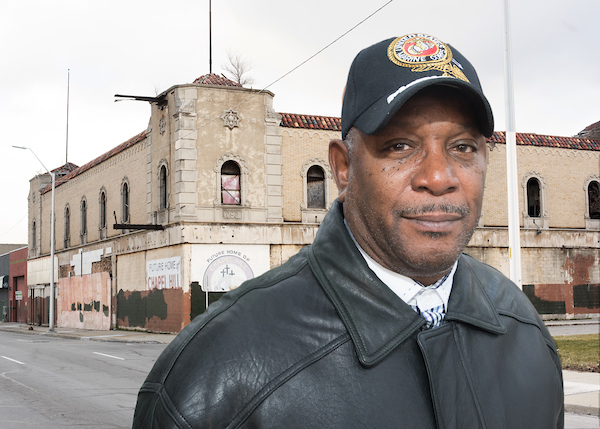The pastor of a Grand River and Joy Road church, whose congregation is bursting at the seams, hopes to convert the aging Grande Ballroom into a rock museum, banquet hall and church for Chapel Hill Ministries.
He joins a team of people who seek to restore the building that once hosted nationally known bands and performers.
“While I am hurt, wounded and injured by the many who have destroyed, demolished, devastated, illegally broken into and stolen most of its history and artifacts,” says R. Lamont Smith II, minister and owner of the 1928 structure, “…I feel that it would be like another death in the city of Detroit to demolish the building.”
Last fall a group including Leo Early, author of The Grande Ballroom: Detroit’s Rock ‘n’ Roll Palace, Krysta Ryzewski, Wayne State professor of urban archeology, Ron Jackson, owner of ECM Construction, and Wayne State University students began assessing the structure.
“The freeze-thaw cycle is just brutal,” warns Smith. “Cornices are falling off, walls could collapse.” On the other hand, he adds, “The Grande could be the keystone property for a much larger neighborhood revitalization project.”

The Grande, designed in Moorish Deco style with first floor retail and a second floor ballroom, once had the capacity to hold 1,500 dancers. In the 1930s and 1940s, it was primarily a Jewish enclave. Then, in 1966, Dearborn schoolteacher Russ “Uncle Russ” Gibbs turned the ballroom into a rock-and-roll emporium to rival the Fillmore Auditorium in San Francisco. Nearly every major band of the era played there, from Jefferson Airplane to The Who.
“The main floor could be a replica of the old Grande Ballroom that is fully functional, and also could also be used as our church,” Smith says. “We could have a museum with voice tutorial with pictures of the old Grande Ballroom. On an upper floor, we could have classes for up and coming musicians taught by the Friends of the Grande.”
But, first, the assessment team has to confront the reality of neglect over decades.
Formerly a Grande patron in the late 1960’s, WSU graduate archaeology student Jeri Pajor toured the building with her professor.
“The second set of stairs to the ballroom was so covered in debris that it was difficult to navigate your way up. I have some mobility issues and the professor had to get a tool to clear away some of the plaster and wood debris so we could make our way up,” says Pajor.
“It was really quite heartbreaking for me to see the Grande in such a condition, since I have vivid memories of sitting cross-legged on the floor, listening to bands like Deep Purple and The Who, or dancing wildly to music by the MC5 and Ted Nugent,” she adds.
Armed with the original blueprints, the team used 3-D imaging to create a virtual exhibit. They found chips of paint, faded posters by Carl Lundgren, bells affixed to walls that communicated with the stage and the sound booth, and scraps of shag carpet from the smoking room, says Ryzewski.
The architects, students and the pastor conducted a full inspection, which they planned over a series of months. The parties say they got permission to enter, since the building is not open to the public, because the interior is so fragile and dangerous.
“Urban archeology helps us tell stories of buildings long-shuttered or neglected,” Ryzewski says.
Her documentation may help Early and Smith seek government loans and historic preservation grants to revive the Grande.

Meanwhile, Pastor Smith has a history of getting things done. His church has built 12 townhouses and plans another 12 to revitalize the community. He hopes for a bigger church to serve more people in the long-neglected neighborhood. The Grande Ballroom played host to a few churches after the rock venue closed in the early 1970s, but nothing lasted. It was mostly empty, except for scavengers who stripped its valuables.
“The support beams are sound, but I can’t tell any more with my eyes. The architects who came with us are making their assessments,” Ryzewski says. She notes plans to renovate the Vanity Ballroom in Jefferson Chalmers on Detroit’s east side, which recently became a national historic preservation district.
“The only way the Grande will be viable is if it serves the neighborhood,” says Early, the author. “It must serve the church’s interest if a business case can be found for its revival.
“We’re open to any and all ideas.”
For more information, visit www.thegrandeballroom.com.
Photos by Paul Engstrom unless noted otherwise.


